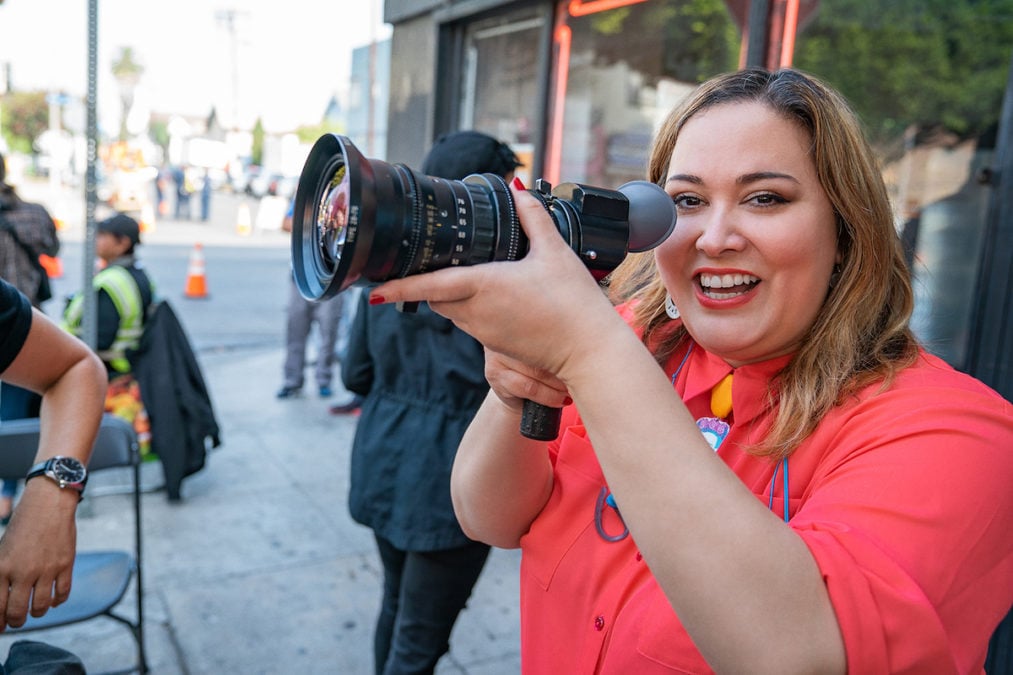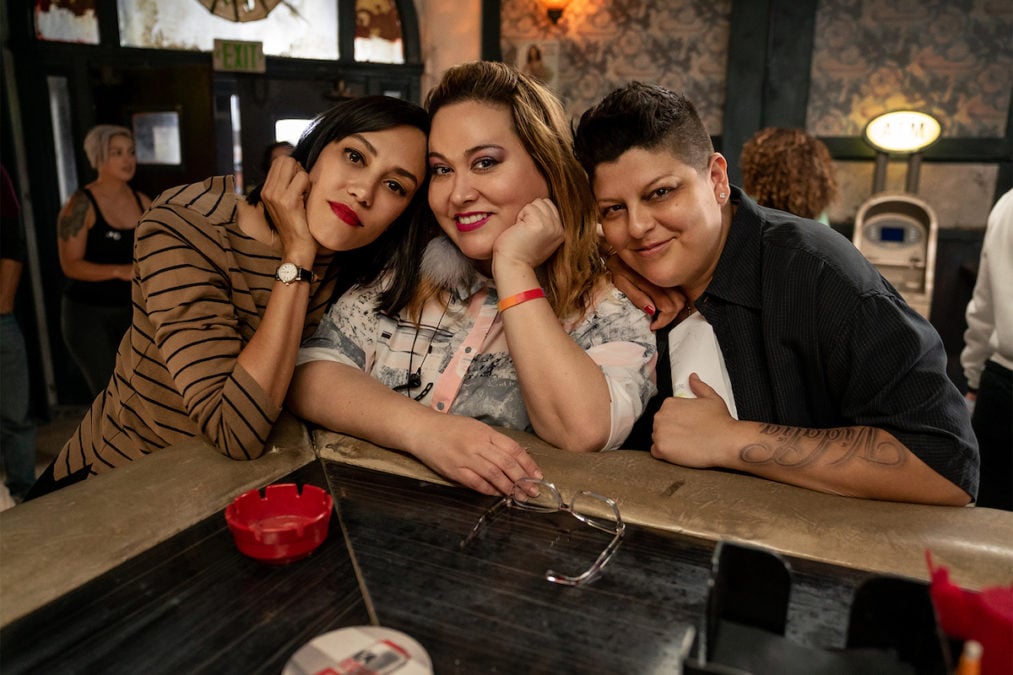The Starz’s series “Vida” was pioneering for its authentic representation of Latinx and queer identified characters living in an East Los Angeles neighborhood.
The story revolves around Lynn and Emma (Melissa Barrera and Mishel Prada), estranged sisters who return to their Boyle Heights neighborhood to bury their mother, who has died unexpectedly.
During their visit, the sisters learn a family secret — Their mother was married to a woman, Eddy (Ser Anzoategui, who in real life uses they/their pronouns, but her character uses she/her).
“The big storyline is that their mother married a woman in secret. That denotes another generation that their mother broke off from, but we don’t get the whole story,” says Tanya Saracho, the series’ creator and showrunner, who identifies as queer. “It’s messy, and I love that. Their mother made this big gesture, but we didn’t get to experience it. The daughters are piecing it together afterward.”
After three seasons, Starz cancelled “Vida” last year. The series was a hit with viewers and received enormous critical acclaim. Each season has a 100% score on review aggregator Rotten Tomatoes. It can be streamed on several services: Netflix, Amazon Prime, Hulu, iTunes, and Vudu.
Eder Díaz Santillan hosts queer Latino podcast ‘De Pueblo, Católico y Gay’
The series won a 2019 GLAAD Media Award for Outstanding Comedy Series. “Vida” is nominated for a 2020 GLAAD Media Award for Outstanding Drama Series.
The GLAAD Media Awards “honor media for fair, accurate, and inclusive representations of LGBTQ people and issues.”
The 32nd Annual GLAAD Media Awards will stream on GLAAD’s YouTube channel April 8 at 8 p.m. EST, 5 p.m. PST.

Tanya Saracho is photographed on the set of “Vida” during filming of season two. Photo: Starz.
On “Vida,” Saracho, who was born in Sinaloa, México, and resides in West Hollywood, assembled an all-Latinx, heavily queer writers’ room that was all female-identified except for one cis-male and a directorial team who were all Latinx or women of color.
At its core, “Vida” is about family and mending broken bonds.
The stories dive into sexism, gentrification, racism, religion, and immigration.
The stories also mirror events in real life Boyle Heights, which tries to hold on to its Latino identity as gentrification impacts the community and changes the city’s demography, which includes a growing LGBTQ population.
Noa Noa Place bar-pizzeria in Boyle Heights caters to LGBTQ Latinos
In an interview with Q Voice News, Saracho, 43, talks about “Vida,” celebrating the queer Latinx experience, the characters who drive the show, and how the series gave her pride.
Here are some experts.
Working on the HBO series ‘Looking’
A former Chicago playwright, Saracho entered series writing when she worked on the HBO series about a group of San Francisco gay friends. Saracho co-wrote several shows during the series’ two seasons, 2013-14 and 2014-15. Her first episode was “Looking in the Mirror,” episode six in season one, when Patrick (Jonathan Groff) introduces his Latino boyfriend Richie (played by Saracho’s longtime friend Raúl Castillo) to his friends.
“Working on ‘Looking’ was the best thing that could ever happen to me,” Saracho says. “Everyone in the room was queer, everyone. It gave me permission to be like, ‘One day I could have this.’
“I felt very included and nurtured and seen,” she says. “That is why it was a perfect way to grow up, and that’s why I had the entitlement of never having to question stuff.”
Making ‘Vida’
“I’m very aware of what a rarity it is to have gotten to make ‘Vida.’ What a privilege it was, and that pisses me off,” Saracho says. “I have to think of it as privilege, as something extraordinary.
“Also, ‘Vida’ is my point of pride because we got to make it unapologeticaly brown and queer,” Saracho says. “We have existed forever, right? But throughout history, every decade and right now, the media, entertainment, TV, film have ignored us, the brown-queer voices. That has sort of caused a cultural erasure.”

Tanya Saracho, center, is photographed on the set of season two of “Vida” with Mishel Prada, who portrays Emma, and Ser Anzoategui, who stars as Eddy. Photo: Starz.
‘Vida’ characters
“Of course all my work is going to deal with my brownness and my queerness,” Saracho says. “I identify as queer, and so I knew one of the sisters was going to be queer. I wanted to explore that, and not describe it, and not make excuses for it. In season one, we saw it in action, but we don’t see it in definition. We are not our identities. We are just steeped in them”
“My show was very steeped in femmes and femaleness, and the different iterations of that,” Saracho says.
Eddy
“The character of Eddy was a masculine butch. We don’t see a lot of brown butches. We populated her circle of friends with people like her,” Saracho says. “That’s radical because we have not had that. It’s not about them being queer. They are just in the story, living their lives.
“Eddy has been that butch in the neighborhood forever, since the 1920s, 30s, and 40s. Brown and thriving, and living their lives, but we just haven’t represented her and haven’t celebrated and fully realized them in the narrative. That’s the part that pisses me off,” Saracho says. “It’s so special. It’s brown and queer, and we’ve never seen anything like this. Why haven’t we?
“There’s a pride and an anger that comes with that, but also, now that I ended the show, or the show got ended for me, I’m so proud that we did get to say so much,” Saracho says. “When do you see brown drag kings on TV? I don’t know why throughout culture we’ve kept away the contributions of drag kings. But, this is an erasure, too, of the culture.”
The executive who championed ‘Vida’
“Can I tell you the secret of ‘Vida’? Marta Fernandez was the woman who found me and gave me the show,” Saracho says. “She was an executive at Starz. It matters that we have one of us in there. She fought for me. It’s DIY, but you have to have a champion in there, especially if you need money to do these things. But a champion is very important.
“Marta made it happen. I had the ideas, and I was like, ‘I want to do this, and I want to do it this way, and I want to cast it this way.’ She was like, Let me work on it,” Saracho says. “You need that kind of co-parenting in this kind of equation. She never said no to all the queer stuff.”
What queer means to her
“It means inclusion, and it means human. To me, it’s the default way to be, and then society changes us,” Saracho says. “I feel like queerness is how we come into the world. Queerness has so many definitions, that’s why I love the term. To me, it’s very human.
“To me, bisexuality is about two genders, and I’m not stuck in the binary. There’s more than two genders. That sort of erases a whole set of genders to me. That’s where I center my queerness. Bisexuality is so binary. I don’t like the term, but I support it because it’s the closet thing that I am.”
Her identity isn’t a phase
“When I date a cis male, some members of my family are like, Oh good she’s over that thing. It’s like that was a phase or something, and I hate that sometimes. With some friends too, it’s like, I guess that was a phase. No, it’s not.
“I do love though that we are embracing queerness and a bunch of identities, just the way we’ve been loving since the beginning of time and now we have names for them, and we defend them,” Saracho says. “We have queer models out there that show you can love who you love.”
Being pigeon-holed
“The mix of brownness, femaleness, and queerness, sometimes in my career, is all people see me as,” Saracho says. “I’m pigeon holed, but also in a lesser way and think, She could never have an opinion or write about anything other than that little niche identity that she is. It’s happening to me right now business wise, and that’s interesting.”
‘Vida’ will not continue
“Starz has been very clear about that,” Saracho says. “I am OK now about it. I wasn’t. I was sad, angry, negotiating, all those stages of grief. But, we got to tell our story unapologetically, and how I wanted to. I’m just leaving this experience in gratitude. Truly, truly. I’m not just saying that.
“ ‘Vida’ was born, and she lived,” Saracho says. “She ends in a very indie cinematic ending, which I think ‘Vida’ can only end. You can fill in the blanks about what happens to all of them. It’s like they’re all ending in essence and emotion, not story.”
